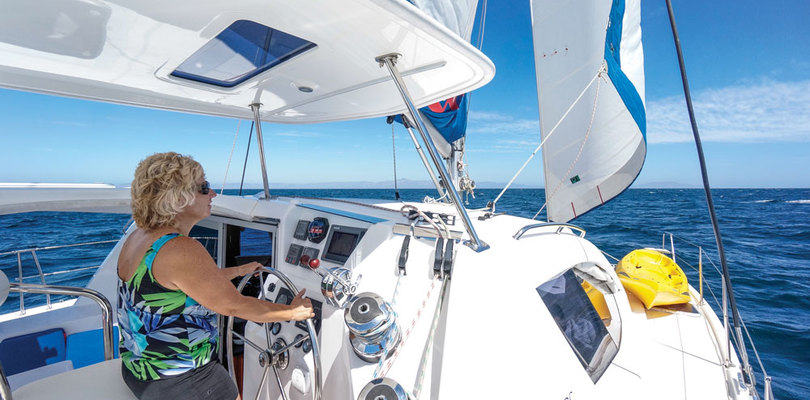Multihull sailing for monohull sailors
Sailing a cat can require forgetting some things and learning a few new tips
I found my ceramic pitcher and glasses in the sink. I didn’t think they needed washing. Then I remembered these guys are monohull sailors. They’re used to putting stuff away before it flies all over the cabin.
Tidy and shipshape is always good. But a cat lets you make a fast getaway. You don’t have to put stuff away. The boat doesn’t heel and stuff doesn’t go flying.

Something about docking
In catamaran sailing, an obsessive-compulsive need to stow every last thing is not the only old habit you can give up. A lot of the skills you worked hard to master in monohull sailing are not only useless, they might actually send you to the back of the multihull class. In fact, it is often easier for me to teach a complete novice how to dock a cat than it is to teach an experienced monohull sailor. Docking and maneuvering a monohull is all about managing momentum. You worked hard to have the confidence to bring a boat in with good speed against a crosswind. You might have to work just as hard to learn to slow down. Maneuvering a cat is all about balance against pressure. The slower you go, the better control you have.
My day on the 45-footer is a good example. It had tight quarters, hazards, two 90-degree turns, gusty crosswinds and spectators right up close. All these things are better handled going backward. With all the thrust and leverage in the back, and the breeze blowing the bow down, a twin-engine cat has natural balance in reverse. But go slow; the rudders are balanced the other way. They get dynamic help for easy steering forward, but water flow over them in reverse will slam them hard against the stops if you let go of the wheel.
Practice holding the boat perfectly still, stern to the breeze. Then inch your way back to a target and stop, hold still, go forward 10 feet and back up to it again. Do this with a lot of friends watching. It’s good practice, because in a busy anchorage or marina you will always have a big, rapt audience, like a NASCAR crowd, watching and waiting for you to hit the wall.
More motoring
We love to sail in and out of the slip, and you should master that because some day you will have to do it. But there are too many days when you just can’t make way without motors, so you better master them, because motoring behavior really is the biggest difference between multihulls and monohulls. Here are a some essential tips:
- Watch your speed. Most cat helm stations are higher off the water than you are used to. Sensation of speed is less, so watch the knotmeter. Racing through a crowded marina can get you to unpleasant places fast.
- Practice motoring with only one engine. Remember the weird old prop walk quirks you mastered with monohulls? In a cat they don’t exist when two engines are running, but when Murphy’s law shuts down one engine, you’re like a one-legged duck, swimming in circles.
- All close maneuvering is done with the engines steering. Forget the wheel. But don’t forget too long. Remember your muted sensation of speed; if your speed starts to creep up to 2 to 3 knots, the wheel steers better than the engines.
Level-headed heeling
You might have worked hard to beat the fear of heeling. Maybe you don’t remember, but odds are the first time you powered up in a blow, you thought you might go all the way over. Now that you enjoy a steady 14-degree angle, you better learn fear again. If you heel that far in a cruising catamaran you’re in trouble. Now forget the fear again, because you won’t ever heel that far.
Until you learn some subtle signs from the boat, you have to watch the wind speed. When you get to know the boat well, you can sense it digging a hole in the water, straining every sheet, grunting under the pressure of being overpowered. Until you can feel those signals, you have to reef by the numbers. When the meter says 20, you probably should reef the main and jib.

Comments